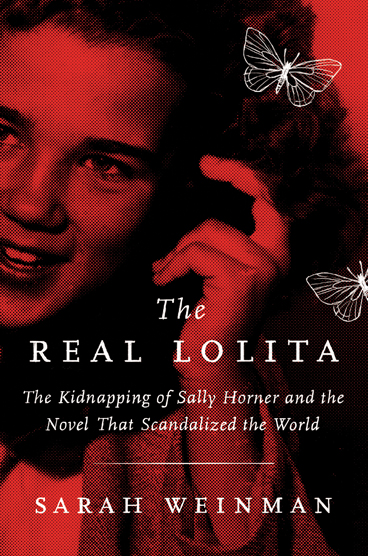
Sarah Weinman Author, Photo Credit Anna Ty Bergman.
(This is the second in a series of reviews leading up to the Miami Book Fair taking place at Miami Dade College's Wolfson Campus, set this year for Nov. 11 through 18, 2018).
"The Real Lolita: The Kidnapping Of Sally Horner And The Novel That Scandalized The World," by Sarah Weinman, Ecco/HarperCollins Publishers, $27.99, Photographs
True-crime writer Sarah Weinman does a thorough, masterful, and convincing job in this tale of what might have inspired Vladimir Nabokov’s runaway 20th-century bestseller "Lolita." Made Nabokov a fortune, enabled him to quit his day job teaching European Literature at Cornell University, and to relocate to elegant digs in Switzerland, where he and his wife Vera resided comfortably for the rest of their lives.
It’s a nasty book, "Lolita." It’s also a masterpiece. Nabokov is truly a nonpareil wordsmith/stylist the equal of the best writers of European classic novels, but the story of pedophile/rapist Humbert Humbert is distasteful and hard to stomach. A young girl is spirited away on a cross-country sexual odyssey after her mother dies and her stepfather – who’s had his lustful eyes on this pre-pubescent darling all along – has his way with her, destroying what could have become of her life.
From where did Nabokov get the idea for this novel?
It apparently, according to Weinman and some few other sources, was germinating in his fertile mind for years. The original manuscript he was writing, "The Kingdom By The Sea, " was frustrating him and he was getting nowhere with it. The real-life abduction of young Sally Horner, in Camden, New Jersey, however, seems to have been the catalyst that transformed this not-quite-there, unsatisfying tale he’d been toying with for several years into what became the global sensation "Lolita." And Weinman proves her case, as I said, masterfully.
This is a meticulous job of research, relying on hard-to-locate print documentation (newspaper and magazine stories, transcripts of trials and other legal materials, clippings dealing with a variety of subjects, Nabokov’s many handwritten notes and the joint diary he and Vera kept as they indulged their hobby of butterfly collecting on their several trips throughout America) as well as personal interviews with as many of the people still alive who could shed light on what had happened to Sally Horner, from her kidnapping by a middle-aged sex offender in 1948 to her rescue in 1950, and to the last two years of her young life. It’s not a pretty story, and others before Weinman have presented bits and pieces of it, but Weinman weaves it all together and it is quite enthralling. She writes clearly and well.
What’s so interesting about Lolita was that Nabokov always insisted his story was “art” and what happened to his fictional lover Dolores Haze had no similarities to what had happened to the real-life Sally Horner. It fooled a lot of people, this assertion, but as a writer of fiction myself I must be honest: we borrow a bit – often quite more than a bit! -- from real life to tell our stories, whether in our depiction of character or in the intricacies of our plots. Reality often provides the needed framework for our narratives. Nabokov was disingenuous to assert otherwise. But he was not alone.

For another example, the British author Graham Greene insisted – as did his biographers -- that the basis of his novel "The Quiet American" came from his imagination, his art – as he claimed all his novels did –and not on the true-life story of a romance between star-crossed lovers in Vietnam, something of which he was very much aware during the last days of the French involvement in that country in the 1950s. Danielle Flood, who was the child of that liaison, effectively shot down his assertion in her wonderful memoir "The Unquiet Daughter"(2016). One has to wonder why it is that these authors protest so much? Do they think it takes away from their artistry?
Weinman says it best in her conclusion when she writes:
There is no simple lock-and-key metaphor to equate the tragic story of Dolores Haze to ... [that] of Sally Horner. Vladimir Nabokov was too shrewd to create a life-meets-art dynamic. But Sally's story is certainly one of those important keys that...unlocks a critical inspiration. There is no question Lolita would have existed without Sally Horner because ... [he] spent over twenty years dwelling on the theme, working it out in bits and pieces as he moved around Europe and America. But the narrative was ... strengthened and sharpened by the inclusion of ...[Sally Horner’s]story.
She goes on to say that it was indeed the unknown-to-so-many young girl Sally Horner whom he “immortalized, and forever trapped, in the pages of a classic novel of satire and sadness, like a butterfly with wings damaged before ever having the chance to fly.”
This is a welcome addition to criticism of the novel "Lolita" and it deserves to be paid attention for its keen insight into the mind of Vladimir Nabokov.
"The Real Lolita" author Sarah Weinman appears Sunday, Nov. 18 at 1 p.m. on Room 2016, Building 2, 1st Floor, Miami Book Fair at MDC's Wolfson Campus, 3000 N.E. 2nd Ave., Miami. Get tickets and information at www.miamibookfair.com, or call 305-237-3528 or email wbookfair@mdc.edu.
 MAIN MENU
MAIN MENU

